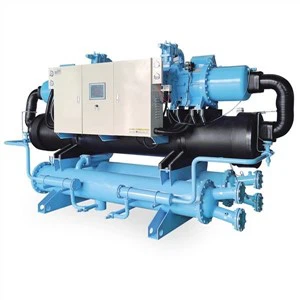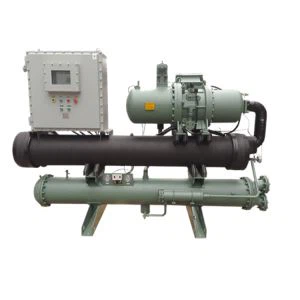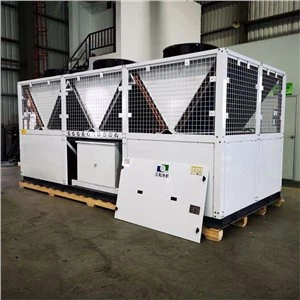When it comes to the operation of a chiller, the screw compressor plays a pivotal role. It is the heart of the chiller system, responsible for compressing the refrigerant gas and maintaining the cooling cycle. However, like any mechanical component, screw compressors have a limited lifespan and may need to be replaced at some point. As a leading Screw Compressor Chiller supplier, I've witnessed firsthand the various costs associated with this replacement process, and I'm here to break them down for you.
1. Compressor Unit Cost
The most obvious cost is the price of the new screw compressor itself. The cost of a screw compressor can vary widely depending on several factors. Firstly, the capacity of the compressor is a significant determinant. Larger chillers require compressors with higher capacities, which generally come with a higher price tag. For example, a small - scale chiller used in a residential or small commercial setting might have a relatively affordable compressor, while a large industrial - grade compressor can cost tens of thousands of dollars.
Secondly, the brand and quality of the compressor also impact the cost. Well - known and reliable brands often charge more for their products, but they usually offer better performance, longer lifespan, and more comprehensive warranties. As a supplier, we offer a range of compressors from different manufacturers to meet the diverse needs and budgets of our customers. You can explore our Water Cooled Screw Type Water Chiller which comes with high - quality screw compressors.
2. Installation Costs
Installing a new screw compressor is not a simple task and requires professional expertise. The installation cost includes several components. Labor costs are a major part of it. Qualified technicians need to be hired to remove the old compressor and install the new one. The complexity of the installation process depends on the chiller's design and location. If the chiller is in a hard - to - reach area or if there are other equipment nearby that needs to be worked around, the installation time will increase, and so will the labor cost.
In addition to labor, there are also costs associated with tools and equipment required for the installation. Specialized tools are needed to disconnect and connect the refrigerant lines, electrical wiring, and other components. These tools may need to be rented or purchased, adding to the overall installation cost. Moreover, the installation process may require the use of safety equipment to ensure the well - being of the technicians, which also contributes to the expenses.
3. Refrigerant Costs
The refrigerant is a crucial part of the chiller's cooling system, and when replacing the screw compressor, the refrigerant may need to be recovered, recycled, or replaced. Recovering the refrigerant from the old system is a necessary step to comply with environmental regulations. This process requires specialized equipment and trained technicians, which incurs costs.


Once the new compressor is installed, the correct amount of refrigerant needs to be added to the system. The type and quantity of refrigerant required depend on the chiller's specifications. Some refrigerants are more expensive than others, especially those that are more environmentally friendly. For example, the transition from older, less - environmentally - friendly refrigerants to newer ones has led to an increase in refrigerant costs in recent years.
4. Downtime Costs
Replacing a screw compressor in a chiller usually means that the chiller will be out of operation for a certain period. This downtime can have significant financial implications for businesses. In commercial and industrial settings, chillers are often used to cool critical equipment, such as servers in data centers or manufacturing processes. Any interruption in the cooling system can lead to equipment overheating, reduced productivity, and potential damage to products or equipment.
For example, in a data center, a few hours of downtime can result in lost revenue due to interrupted services, as well as potential long - term damage to the reputation of the business. In a manufacturing plant, downtime can halt production lines, leading to delays in product delivery and increased costs associated with rescheduling and catching up on orders. These downtime costs can be substantial and should not be overlooked when considering the overall cost of compressor replacement.
5. Testing and Commissioning Costs
After the new screw compressor is installed, the chiller system needs to be tested and commissioned to ensure that it is operating correctly. This process involves checking the refrigerant levels, the compressor's performance, the electrical connections, and the overall cooling capacity of the chiller.
Testing equipment is required to measure various parameters, such as pressure, temperature, and flow rate. The technicians need to analyze the test results and make any necessary adjustments to optimize the system's performance. Commissioning the chiller also involves programming the control system to ensure that the chiller operates efficiently and safely. All these activities require time and resources, which contribute to the overall cost of the compressor replacement.
6. Training Costs
If the new screw compressor has different features or operating requirements compared to the old one, it may be necessary to train the chiller operators. Training ensures that the operators can use the new compressor correctly, perform routine maintenance tasks, and troubleshoot any potential issues.
Training can be provided in - house or by the compressor manufacturer. In - house training may require the allocation of internal resources, such as trainers and training materials. External training provided by the manufacturer usually comes with a fee, which includes the cost of the training session, travel expenses for the trainer (if applicable), and any training materials provided.
7. Maintenance and Warranty Costs
Once the new screw compressor is installed and commissioned, there are ongoing maintenance costs. Regular maintenance is essential to ensure the long - term performance and reliability of the compressor. This includes tasks such as changing filters, checking lubricant levels, and inspecting the electrical components.
The frequency and complexity of maintenance depend on the compressor's design and usage. Some compressors may require more frequent maintenance, which means higher maintenance costs over time. Additionally, purchasing an extended warranty for the new compressor can provide peace of mind but also comes at a cost. A warranty can cover the cost of repairs or replacements in case of a malfunction, but the price of the warranty varies depending on the length and scope of coverage.
As a Screw Compressor Chiller supplier, we understand that these costs can be a significant concern for our customers. That's why we offer comprehensive solutions to help you manage these expenses. We provide high - quality compressors at competitive prices, professional installation services, and after - sales support to ensure that your chiller operates smoothly. If you are considering replacing a screw compressor in your chiller, we encourage you to contact us for a detailed quote and consultation. We can work with you to find the most cost - effective solution that meets your specific needs. You may also be interested in our Industrial Use Screw Water Chiller 2 Compressor and Water Cooled Screw Chiller with Water Pump and Water Tank.
References
- ASHRAE Handbook of Refrigeration. American Society of Heating, Refrigerating and Air - Conditioning Engineers.
- International Institute of Refrigeration (IIR) Guidelines on Refrigerant Management.
- Manufacturer's manuals and technical documentation for screw compressors and chillers.






